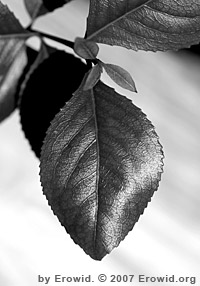Khat Faces Legal Challenges
Nov 2007
Citation: Erowid F. "Khat Faces Legal Challenges". Erowid Extracts. Nov 2007;13:3.

|
Over the past year, a number of federal and state cases have been brought against individuals for importing and distributing khat in the U.S. Much of that khat originated from Kenya and moved through England before entering the country--a journey that takes around five days. The transportation time is important because once the leaves are picked, the cathinone breaks down into a different chemical, cathine, in as few as two days.
Cathine was "temporarily" placed in Schedule IV by the DEA in 1988 to bring the U.S. into compliance with the 1971 Convention on Psychotropic Substances, which established an international control system for psychoactive drugs.1 No further regulatory action was taken. Substances that are placed in Schedule I by "temporary" or "emergency" ruling must undergo a formal review process within 18 months in order to be permanently scheduled (as with BZP and AMT in recent years). However, when a substance is "temporarily" scheduled to meet treaty obligations, the Controlled Substance Act requires only that the review process be completed within a "reasonable time". This clearly did not happened in the case of cathine.
One lawyer who has defended over 70 people charged with possession or conspiracy to import or distribute khat argues that by the time the leaves reach the U.S. their cathinone has degraded, leaving only cathine. He further contends that "a chemical can not be temporarily listed for 19 years" and notes that in all federal khat-related cases he has handled, "the Justice Department has conceded this point" and prosecutors were not allowed to refer to cathine as a scheduled chemical.2 However, a charge of conspiracy to import/distribute does not require that cathinone be present, only that a defendant knowingly tried to import or distribute it. One defendant in New York was recently found guilty of these two charges despite the jury's finding that no cathinone remained in the khat at time of distribution. Since most states have now scheduled cathine, state charges could be brought for possession or distribution of khat on the grounds that it contains cathine.
Whether or not a plant that contains a scheduled substance is itself illegal to possess is an issue that has come up frequently in recent years. The Official Commentary of the Convention on Psychotropic Substances states that a plant that contains a Schedule I substance is not illegal, though an extract of that same plant likely would be. Many European countries have taken a similar position regarding plants that contain chemicals from any schedule, but the U.S. is inconsistent on this point. Mescaline-containing cacti, LSA-containing seeds, and DMT-containing plants are regularly sold by botanical companies and gardening stores without legal trouble. Charges have been brought against a few individuals for importing or selling such plants, usually in cases where the vendor is demonstrably aware of a plant's psychoactive properties. In the case of Catha edulis, the FDA issued an alert in 1993 (prior to cathinone being placed in Schedule I) stating that Catha edulis "would be subject to the same controls as cathine" and should be seized at the border.3
In January 2007 we were contacted by the lawyer in the New York case. He had seen the glass molecules Erowid offers as membership gifts, and asked if we could provide him with a cathinone molecule to use in his case. We worked with the glass artist to fulfill the lawyer's request. The lawyer reported that he "used the glass molecule to good effect in the jury trial in New York to demonstrate [...] how the hydrogens would latch onto the cathinone molecule and convert it to cathine." The chemist who testified for the lawyer then explained that when using mass spectrometry--an analytical method for identifying chemicals in plants or other material--these two similar molecules are very difficult to tell apart.
Judges in different jurisdictions appear to be handling khat cases differently. Two defendants in Ohio were sentenced to 20 years each because of an Ohio requirement that plant material be included when calculating the weight of a Schedule I substance (cathinone).2 Five Seattle defendants facing federal charges of conspiracy to import and distribute khat had all charges against them dropped in May 2007--although prosecutors retained the right to re-file charges in the future.4 Others have signed plea agreements in an attempt to lessen possible prison sentences.
It seems that the ongoing attempts to control Catha edulis are due at least in part to its use primarily by Muslims from Africa and the Saudi Arabian peninsula, with many of the defendants being Somali immigrants. Unfortunately, selective enforcement of drugs laws is as old as drug laws themselves.
References #
- Federal Register. May 17, 1988. 53 FR 17459.
- Moore S. Personal communication. Sep 2007.
- Food and Drug Administration. "Automatic Detention Alert for Catha edulis". IA#66-23. Feb 9, 1993.
- Bowermaster D. "Charges in Khat Case Dropped". Seattle Times. Jun 19, 2007.


